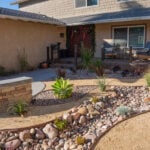A well-manicured and aesthetically pleasing yard is the envy of every homeowner. The allure of a beautifully landscaped yard goes beyond mere visual appeal; it can enhance the value of your property and provide a tranquil oasis for relaxation. But creating a floral beauty in your outside area is not free. In this thorough guide, we’ll examine the several elements that affect landscaping costs and offer advice on how to set a budget for your ideal yard.
Factors Influencing Landscaping Costs
Yard Size and Complexity:
The sheer size of your yard is a fundamental factor in determining the cost of landscaping. Larger yards generally require more materials, labor, and time, leading to increased expenses. Additionally, the complexity of the terrain and existing features such as slopes, hills, or water bodies can significantly impact costs. A flat, open space is generally less expensive to landscape than a yard with intricate topography.
Design and Planning:
The level of intricacy in your landscaping design plays a crucial role in cost estimation. If you’re looking for a simple garden with a few flower beds and shrubs, your expenses will be considerably lower than if you opt for a sophisticated design involving intricate hardscaping elements, water features, and custom structures. Hiring a professional landscape designer can add to the upfront costs but can streamline the process and ensure a cohesive, visually appealing result.
Materials Selection:
The choice of materials significantly impacts the overall cost of landscaping. While more expensive initially, high-grade, long-lasting materials can pay you in the long run in terms of upkeep and appearance. A variety of hardscape elements, plants, trees, mulch, dirt, rocks, and pavers are common landscaping materials. Additionally, if you opt for rare or exotic plants, custom-designed features, or imported materials, expect your costs to rise accordingly.
Labor Costs:
The cost of labor is a substantial component of any landscaping project. Skilled laborers, such as experienced landscapers and horticulturists, may charge higher rates, but their expertise can contribute to a more successful and lasting project. Labor costs also depend on the complexity of the job. Basic tasks like planting and mulching may cost less compared to complex hardscaping installations or excavation work.
Hardscaping Elements:
Introducing hardscaping elements like patios, pathways, retaining walls, and outdoor kitchens can significantly enhance the functionality and aesthetics of your yard. However, these features typically come with higher costs due to the materials involved and the specialized skills required for installation. The choice of materials, such as natural stone or high-quality pavers, will impact the overall cost of hardscaping.
Plant Selection:
The type and quantity of plants you choose for your landscaping project can greatly influence costs. While standard, locally sourced plants are generally more affordable, selecting rare or exotic species can significantly increase expenses. Consider the climate and soil conditions in your region to ensure the chosen plants thrive, minimizing the risk of replacement costs.
Irrigation and Lighting:
Essential for maintaining a healthy landscape, irrigation systems are an investment that can affect your budget. Drip irrigation, automatic sprinklers, or smart watering systems are convenient but may cost more upfront. Similarly, outdoor lighting can add a magical touch to your yard but comes with additional costs for fixtures, wiring, and installation.
Budgeting
Research and Planning:
Before diving into a landscaping project, conduct thorough research and define your goals. Understand the needs of your yard, including soil conditions, sunlight exposure, and climate. This knowledge will help you make informed decisions on plant selection and design elements. Additionally, seek inspiration from landscaping magazines, online platforms, or professional designers to develop a clear vision for your project.
Set Realistic Goals:
Establish realistic goals based on your budget constraints. Prioritize essential elements and consider phasing the project over time if necessary. This approach allows you to achieve your landscaping dreams without compromising your financial stability.
Obtain Multiple Quotes:
Contact several landscaping professionals to obtain detailed quotes for your project. Be specific about your requirements, including the type of plants, materials, and features you desire. This will help you compare quotes accurately and identify any potential discrepancies.
Consider DIY Options:
While some aspects of landscaping require professional expertise, there are tasks you can tackle on your own to cut costs. Planting, mulching, and basic maintenance are areas where a homeowner with a green thumb can contribute. However, for complex tasks like hardscaping or irrigation installation, hiring a professional is often advisable to ensure the longevity and quality of the work.
Factor in Contingencies:
Landscaping projects, like any construction endeavor, may encounter unforeseen challenges. It’s wise to allocate a portion of your budget for contingencies to cover unexpected expenses. This buffer can help you navigate surprises such as soil issues, drainage problems, or hidden obstacles that may arise during the course of the project.
Crafting Beauty
Landscaping your yard is an exciting endeavor that can transform your outdoor space into a haven of beauty and tranquility. Although landscaping can appear expensive, with careful planning, realistic goal-setting, and well-considered decision-making, you can create your ideal yard on a budget. Recall that you can create a landscape that will increase the value of your home and bring you years of delight by investing in high-quality materials and skilled knowledge. By understanding the various factors influencing landscaping costs and taking a thoughtful approach to budgeting, you can turn your vision into reality and create a stunning outdoor oasis tailored to your preferences.






